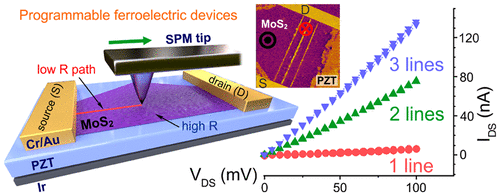当前位置:
X-MOL 学术
›
Nano Lett.
›
论文详情
Our official English website, www.x-mol.net, welcomes your
feedback! (Note: you will need to create a separate account there.)
Nanodomain Engineering for Programmable Ferroelectric Devices
Nano Letters ( IF 9.6 ) Pub Date : 2019-04-03 00:00:00 , DOI: 10.1021/acs.nanolett.9b00673 Alexey Lipatov 1 , Tao Li 2, 3 , Nataliia S. Vorobeva 1 , Alexander Sinitskii 1, 4 , Alexei Gruverman 2, 4
Nano Letters ( IF 9.6 ) Pub Date : 2019-04-03 00:00:00 , DOI: 10.1021/acs.nanolett.9b00673 Alexey Lipatov 1 , Tao Li 2, 3 , Nataliia S. Vorobeva 1 , Alexander Sinitskii 1, 4 , Alexei Gruverman 2, 4
Affiliation

|
We introduce a concept of programmable ferroelectric devices composed of two-dimensional (2D) and ferroelectric (FE) materials. It enables precise modulation of the in-plane conductivity of a 2D channel material through nanoengineering FE domains with out-of-plane polarization. The functionality of these new devices has been demonstrated using field-effect transistors (FETs) fabricated with monolayer molybdenum disulfide (MoS2) channels on the Pb(Zr,Ti)O3 substrates. Using piezoresponse force microscopy (PFM), we show that local switching of FE polarization by a conductive probe can be used to tune the conductivity of the MoS2 channel. Specifically, patterning of the nanoscale domains with downward polarization creates conductive paths in a resistive MoS2 channel so that the conductivity of an FET is determined by the number and length of the paths connecting source and drain electrodes. In addition to the device programmability, we demonstrate the device ON/OFF cyclic endurance by successive writing and erasing of conductive paths in a MoS2 channel. These findings may inspire the development of advanced energy-efficient programmable synaptic devices based on a combination of 2D and FE materials.
中文翻译:

可编程铁电器件的纳米域工程
我们介绍了由二维(2D)和铁电(FE)材料组成的可编程铁电设备的概念。它通过具有平面外极化的纳米工程FE域,能够精确调制2D通道材料的平面内电导率。这些新设备的功能已通过在Pb(Zr,Ti)O 3衬底上使用单层二硫化钼(MoS 2)通道制造的场效应晶体管(FET)进行了演示。使用压电响应力显微镜(PFM),我们显示通过导电探针对FE极化进行局部切换可用于调整MoS 2通道的电导率。具体而言,对具有向下极化的纳米级畴进行构图会在电阻MoS中创建导电路径2通道,因此FET的电导率由连接源电极和漏电极的路径的数量和长度确定。除了器件的可编程性之外,我们还通过连续写入和擦除MoS 2通道中的导电路径来演示器件的开/关循环耐久性。这些发现可能会激发基于2D和FE材料组合的高级节能可编程突触设备的开发。
更新日期:2019-04-03
中文翻译:

可编程铁电器件的纳米域工程
我们介绍了由二维(2D)和铁电(FE)材料组成的可编程铁电设备的概念。它通过具有平面外极化的纳米工程FE域,能够精确调制2D通道材料的平面内电导率。这些新设备的功能已通过在Pb(Zr,Ti)O 3衬底上使用单层二硫化钼(MoS 2)通道制造的场效应晶体管(FET)进行了演示。使用压电响应力显微镜(PFM),我们显示通过导电探针对FE极化进行局部切换可用于调整MoS 2通道的电导率。具体而言,对具有向下极化的纳米级畴进行构图会在电阻MoS中创建导电路径2通道,因此FET的电导率由连接源电极和漏电极的路径的数量和长度确定。除了器件的可编程性之外,我们还通过连续写入和擦除MoS 2通道中的导电路径来演示器件的开/关循环耐久性。这些发现可能会激发基于2D和FE材料组合的高级节能可编程突触设备的开发。















































 京公网安备 11010802027423号
京公网安备 11010802027423号